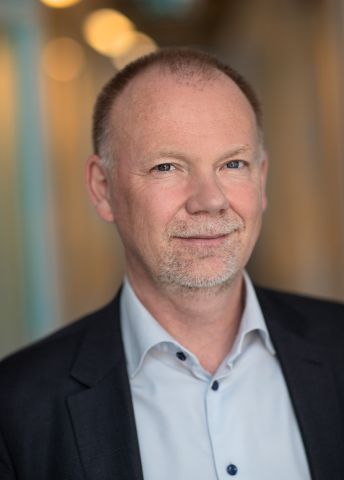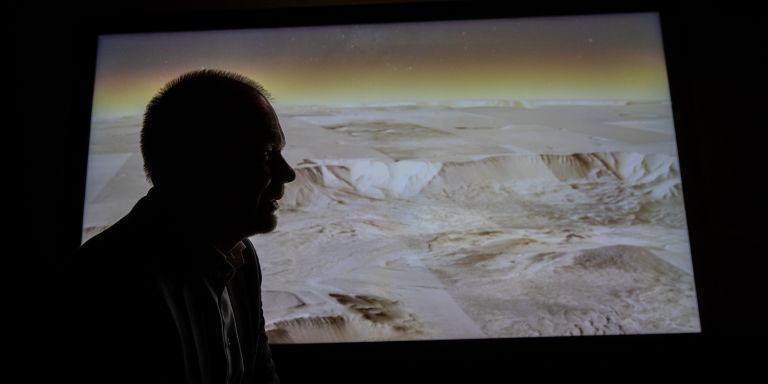
Anders Ynnerman
Professor of Scientific Visualization
Wallenberg Scholar
Institution:
Linköping University
Research field:
Scientific Visualization


Wallenberg Scholar
Institution:
Linköping University
Research field:
Scientific Visualization
“It may sound as though I am a doctor, radiologist, astronomer and AI expert all rolled into one, but that’s because we derive much of what we do from questions arising in applications that are of great importance, both to science itself, and in practice,” explains Ynnerman, who is Professor of Scientific Visualization at Linköping University, and a Wallenberg Scholar.
One of the products that his research team has developed is a visualization table, which makes it possible to carry out virtual autopsies, or to see inside mummies without damaging them. This ability is useful both for research and for education. Another application is virtually furnished rooms, where furniture is displayed with photorealism without actually being there.
“The applications are based on a fundamental theoretical, methodical core, such as mathematics, computer science, and to some extent principles of physics. We possess knowledge that can be used in many fields. I usually say we’re toolmakers making adjustable wrenches that can be used for virtually any purpose. But since the results are such vivid visualizations, we are usually associated with the results rather than the underlying technology.”
Ynnerman’s interest in visualization applications has also reached space. He is heading a project entitled Open Space, based on software of the same name, whose development is being led by the team in Norrköping. The space data gathered in the interactive software enable visitors to take trips in space and visit Mars from the dome theater at Visualization Center C in Norrköping, where Anders is also Director.
The project, which mainly involves researchers at U.S. universities and NASA, is in receipt of U.S. funding, with the result that Ynnerman is also Adjunct Professor at the University of Utah, and a Research Fellow at the American Museum of Natural History i New York.
He also researches on autonomous systems, and was one of the 16 researchers involved in the application for what is now the major WASP-Project, in which he plays a leading role. As a Wallenberg Scholar, he wants to focus mainly on visualization of artificial intelligence (AI).
“I want to use visualization to understand AI, but also to use AI for better visualization.
My research will also include a greater element of basic science than previously.”
“In everything to do with machine learning, we see a need to create a more fundamental understanding of what happens in the black box of AI – in the network. What is it that enables the network to be trained to identify a dog, for instance? Self-driving car systems are shown millions of traffic situations, but how have they learnt to understand them? How do they make decisions? And what happens when things go wrong – when they think a dog is a parrot for example?”
There are many questions, which is not surprising, given that the network is made up of millions of parameters. But even though we do not yet understand how it works in detail, and although AI is still not performing to its full potential, the technology is making inroads in applications such as self-driving cars, and in numerous diagnostic healthcare systems as a means of finding tumors in X-ray images, for instance.
“We are pretty sure that these systems will need a human in the loop for a long time to come. Advanced interaction will have to be built into decision support systems. This requires a communication system, and the best kind is visual.”
He thinks that research to date has often overlooked the interactive dimension.
“The human interface is a key component in the autonomous society, and perhaps it’s an issue we haven’t really addressed properly yet.”
Ynnerman’s research spans a broad spectrum, and rests on a solid foundation. Indefatigable curiosity and a desire to understand how things work have given him knowledge leading to an internationally pre-eminent position in the field of visualization technology.
As a six-year-old in Varberg on the west coast of Sweden, he was fascinated by the moon landing and the sky at night: his interest in science and technology was awakened. Thanks to the efforts of his physics teacher in high school, he pursued the subject at Lund University, followed by a PhD in atomic physics at the University of Gothenburg. After a period of basic research in physics, followed by applied research, he moved on to computer science.
“I made supercomputer calculations during my second stint as a postdoc, in Nashville, and was one of the first people to use parallel computers. I became increasingly fascinated by analysis – visualization didn’t exist in those days.”
He returned to Sweden in 1995 to develop a national operational infrastructure for supercomputing. Having completed that project, he moved to Warwick in the U.K. for a while, where he started developing visualization technology for plasma physics. Once again he was tempted back to Sweden, this time to head the National Supercomputer Center. This marked a two-year period of commuting between Warwick, Oxford and Linköping.
He then received a new offer, this time to develop an environment incorporating media, computer science and visualization in Norrköping, at Linköping University. Since then, the research department has grown from Anders working half-time, assisted by a PhD student, to 80 full-time staff.
At the same time he was asked to establish and head what was to become Visualization Center C in Norrköping.
“My wife and I said we didn’t want to move to Norrköping, but we went there, had a look around, and were impressed by the city and its ambitions…and twenty years later I’m still there.”
Text Carina Dahlberg
Translation Maxwell Arding
Photo Magnus Bergström